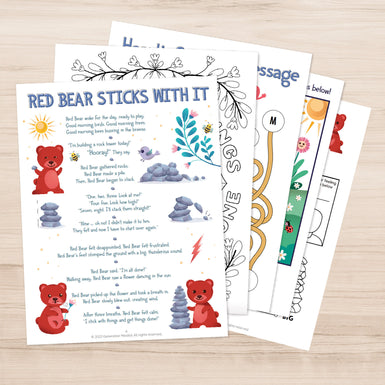As parents, we are often searching for tools to teach our children about their emotions, especially those unpleasant ones. But who is helping us with ours?
What am I supposed to do with my overwhelm when I can’t get a break and there is no respite?
How do I channel my frustration without yelling at my child and snapping at my partner?
How do I express my sadness and disappointment without my child taking on my emotions?
When we become new parents, we Google until our thumbs fall off about best nursing practices, safest car seats, healthiest foods, milestones, and discipline trends for managing our children. As I have become a more seasoned parent with some years under my belt, the one thing I wish someone would have told me was to look at my own emotional regulation. Where was the class for that?
Because let me tell you, nothing is more challenging than attempting to regulate my child while my own inner emotional thermostat is running chaotically. Nothing is more guilt-inducing than lashing out at my children for being children. And nothing is more exhausting than becoming caught in a cycle of being triggered by my child, swept up in their big emotions, and exploding.
And perhaps the even bigger question is, how am I supposed to teach my children what I don’t know? Never did I ever have an adult sit with me to ask me what I think let alone how I feel. So when I ordered a Time-In ToolKit and hung the feelings posters on the wall with my sons, I felt like a child too, as clueless as my one and three-year-olds.
My eyes could see the feeling faces on the poster, and my head could process the words “sad, calm, and mad,” but my body didn’t know what those felt like. I wanted to explain them to my boys but no words would come. That’s when I had a realization: This ToolKit was just as much for me as it is for my kids.
Time-Ins For The Inner Child
The concept behind Time-Ins is to meet our children where they are, help them notice feeling sensations, and name them so that we can dive under the surface behavior and into building the brain for regulation. This happens through co-regulation.
Co-regulation thrives off relationships, an exchange of energy between two people, you and your child … me and my child. Our nervous systems are wired that way. For me to really see and reflect my child, I needed to see and reflect the child within me. To witness her and validate her and give her what she needed when she was young.
This is when I recognized something really interesting - the Time-In ToolKit wasn’t made for our children. It was made for us. The adult. An opportunity to understand and heal the wounded parts of ourselves so that we can be with our children in the present without our biases and conditioned lenses. It’s an invitation to explore the shadows of our psyche and the depths of our hearts to recognize that our children are seeking safety and connection like we were (and often still do).
Here are some perspective shifts when using the Time-In ToolKit for your inner child:
If my child is inherently good, so am I.
If my child’s behavior doesn’t define him, nor does mine.
If my child’s emotions are valid and safe, so are mine.
Becoming my own safe attachment - being an adult my inner child could count on and trust - became my starting point.
Time-Ins For The Adult
I realized that “good” parenting isn’t just about buying the most organic foods or organizing the most playdates or any other external factor. It is much more internal and relational than that. For me, it became about being the best version of myself (which would never be a perfect model). It was about me putting in the energy to notice and regulate myself so that I could be a guide for my children to mirror.
In creating safety for ourselves, we create safety for them. Here are some of the ways to put this into action.
1. Do a trigger worksheet (or several). This is a seven-step process to notice your emotional state in the face of whatever is happening. This is the place to reclaim your power. It has nothing to do with overpowering your child but rather focusing on how you think and feel, understanding why you think and feel the way you do, and creating goals for yourself. When you realize that you control yourself and influence your children, parenting becomes more like freedom than war.
2. Find the pause. This could be the most challenging step. Next time you feel unpleasant energy seeping into your being, pause and notice it. Accept it without attempting to change it. Breath into it. This pause could be three seconds or twenty, or longer if needed. Taking this time to witness your emotional climate is often the space between reacting and responding.
3. Listen to your body. This is a two-parter. How does your body feel and what emotion do you attach to those physical sensations? Once you know, verbalize it. In putting words to your emotional experience, it helps create circuits from your brainstem wired to fight and flight and to your cortex wired for emotional regulation. “I can feel the flutters in my tummy and my hands are jittery. I feel nervous.” or “I can feel my jaw and hands clenching. I feel angry.”
4. Talk to your body. Now that you have listened to your body, ask it what it needs. Does it need to sit and cry? Does it need to take some deep breaths? Does it need closeness or does it need space? Whatever you need, honor it and gift that to your nervous system.
5. Create family rituals. Choose a consistent time of the day to come together as a family for playful connection, learning about the emotions together. You may choose things like Feelings Charades, mimicking the feelings, or Feelings Bingo. Or perhaps you come together as a family each night to share about when you felt emotions from each mood group. “Today I felt happy/sad/calm/mad when ...”
In doing these steps and going to the Calming Corner yourself and with your child, you are modeling emotional regulation. Your child’s nervous system will begin to mirror yours. And if you are anything like me, you’ll go weeks thinking it “isn’t working” and then one day your child will pause before she hits or he will share, “I feel sad” when something is sad. And because you let them into your world, they feel safe asking you into theirs.





















